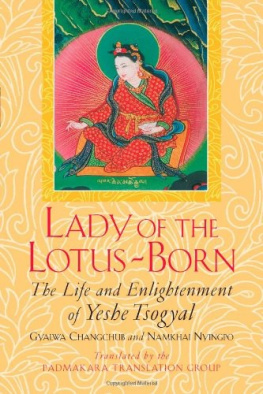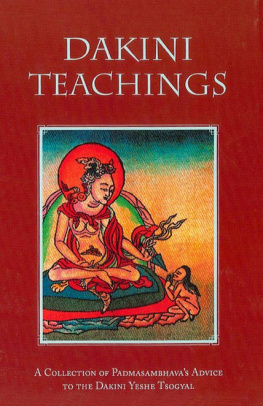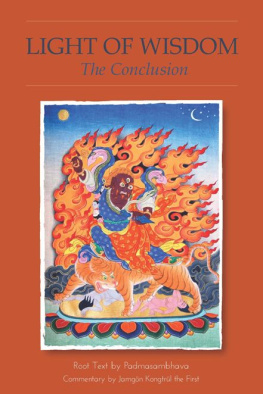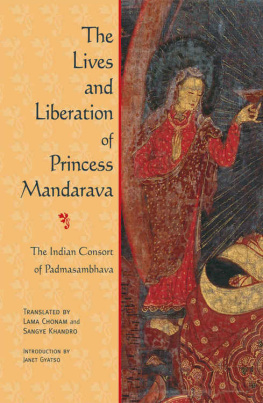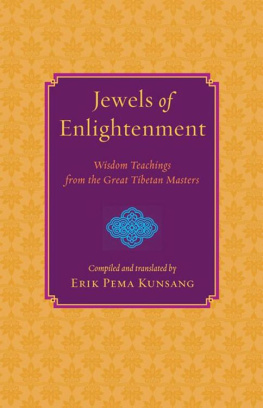Clear and readable, Lady of the Lotus-Born will reward students and scholars.
Library Journal
ABOUT THE BOOK
The first Tibetan to attain complete enlightenment was in all probability the woman Yeshe Tsogyal, the closest disciple of Padmasambhava, the master who brought Buddhism to Tibet in the eighth century. This classical text is not only a biography but also an inspiring example of how the Buddha's teaching can be put into practice. Lady of the Lotus-Born interweaves profound Buddhist teachings with a colorful narrative that includes episodes of adventure, court intrigue, and personal searching. The book will appeal to students of Tibetan Buddhism and readers interested in the role of women in Buddhism and world religions.
THE PADMAKARA TRANSLATION GROUP is a team of translators and editors of various nationalities specializing in the translation of Tibetan texts and teachings, mainly into English, French, German, and Spanish.
Sign up to learn more about our books and receive special offers from Shambhala Publications.

Or visit us online to sign up at shambhala.com/eshambhala.

Shambhala Publications, Inc.
Horticultural Hall
300 Massachusetts Avenue
Boston, Massachusetts 02115
www.shambhala.com
1999 by the Padmakara Translation Group
All rights reserved. No part of this book may be reproduced in any form or by any means, electronic or mechanical, including photocopying, recording, or by any information storage and retrieval system, without permission in writing from the publisher.
The Library of Congress catalogs the previous edition of this book as follows:
Nam-mkha i-snying -po, 8th/9th cent.
[Bod kyi jo mo Ye-es Mtsho-rgyal gyi mdzad tshulrnam par thar pa khab po mnon buyn rgyud mans dri za i glu phre. English]
Lady of the lotus-born: the life and enlightenment of Yeshe-Tsogyal / Namkhai Nyingpo and Gyalwa Changchub; discovered by Tertn Taksham Samten Lingpa; translated by the Padmakara Translation Group.1st ed.
p. cm.
eISBN 978-0-8348-2462-1
ISBN 978-1-57062-384-4
ISBN 978-1-57062-544-2 (pbk.)
1. Ye-es-mtsho-rgyal, 8th century. 2. YogisChinaTibetBiographyEarly works to 1800. 3. Yoga (Tantric Buddhism)Early works to 1800.
I. Gyalwa Changchub. II. Tertn Taksham Samten Lingpa. III. Title.
BQ998.E757N3513 1998 98-6838
294.3923092dc21 CIP
[b]

Contents

T HE STORY OF the life of Yeshe Tsogyal is not merely an absorbing historical document. It is, above all, one of the most inspiring examples of how the Buddhas teachings may be put into practice.
In the early days of Buddhism in Tibet, many of the sacred texts were translated several times from Sanskrit, each version complementing the others and contributing to a complete understanding of the original. In the same spirit, although this extraordinarily important text has already been made available to English readers by the skilled efforts both of Tarthang Rinpoche and his students and of our friend Keith Dowman, we feel that in these early days of Buddhism in the West, to produce another translation, as a way of further acquainting ourselves with the life of Yeshe Tsogyal, may be of some benefit. Throughout this undertaking, we have felt an immense gratitude to all the great masters of our tradition, whose compassionate activities have kept Yeshe Tsogyals teachings a living source of inspiration even today.
The question is sometimes asked whether Buddhism is a system of belief and practice applicable only in a particular social context. This text, however, describes for us a struggle for spiritual freedom in a whole range of existential predicaments: those of princess, renunciate, ascetic, or teacher, to name but a fewa whole spectrum of circumstances on which the teachings shed their light and open up new and fresh opportunities. Again, it might be suggested that the tradition of Tibetan Buddhism, in the development of which Yeshe Tsogyal played such a crucial role, is something suitable only for Tibetans. But here again, we find that for Yeshe Tsogyal herself, the Buddhadharma was far from being a foreign, exotic practice imported from India; it was the means to reach the very essence of human experience. Neither is it possible to dismiss this text as the glorification of arduous trials. For on the contrary, it is clear that Yeshe Tsogyal consciously decided to tell her story as a help to us in our own lives. She simply shares, without asking for pity or admirationpresenting her experience not as mystical or superhuman, but as something profoundly natural and human. Her youthful disillusionment with the ways of the world, her introduction to the teachings, and her training in them, step by step, are all told simply and straightforwardly. Not once do we see her reacting to the desperate situations she finds herself in with self-pity or a tortured sense of martyrdom. In fact, it is her ability to make positive and creative use of whatever came her way that is the greatest of all the messages that come to us in her wonderful biography. It is this that makes her life so extraordinary. May all who read it find encouragement and inspiration!
JIGME KHYENTSE RINPOCHE
Padmakara
March 1995

T HE PRESENT VERSION of the Yeshe Tsogyal Namthar grew out of a project to make the work available in French, and it has been a labor of love rather than the expression of any kind of rivalry or the pretension to improve on the already existing translations of Ven. Tarthang Tulku and Keith Dowman. The text is difficult, spectacularly so in many places. Given its subject matter, this is hardly surprising, but in any case the text is ancient and has many old words and expressions. The translation no doubt has many defects, but this has nothing to do with the eminent authorities who were consulted as often as was possible. In particular we wish to express our profound gratitude to the late Kyabje Dilgo Khyentse Rinpoche, who graciously answered questions on difficult points during his last visit to the West in 1991. Likewise, we owe a great debt of gratitude to Khetsun Zangpo Rinpoche, who generously gave of his time to clarify many passages. Very particularly, we wish to thank Alak Zenkar Rinpoche, who had the kindness to go through the entire text with us and who, with his prodigious knowledge of the Tibetan language, was able to shed light on many a mysterious expression. For it turned out that the text contains many words that have wholly disappeared from standard Tibetan in both its colloquial and erudite forms but that have survived in the language of the nomads of the great plains of north and east Tibetamong whom Alak Zenkar was born and with whose dialects he is familiar. Finally, as always, we wish to express our deepest thanks to our teachers, Taklung Tsetrul Pema Wangyal Rinpoche and Jigme Khyentse Rinpoche, who bestowed the transmission of the text and constantly encouraged us in the work of translation.
Lady of the Lotus-Born was translated by the Padmakara Translation Group, which on this occasion consisted of Helena Blankleder and Wulstan Fletcher. The translators would like to thank their readers for their valuable suggestions: Michal Abrams, Barbara Gethin, Ani Ngawang Chdrn, Charles Hastings, Anne Benson, Adrian Gunther, Geoffrey Gunther, Vivian Kurz, Pamela Low, and Jenny Kane.
Next page
